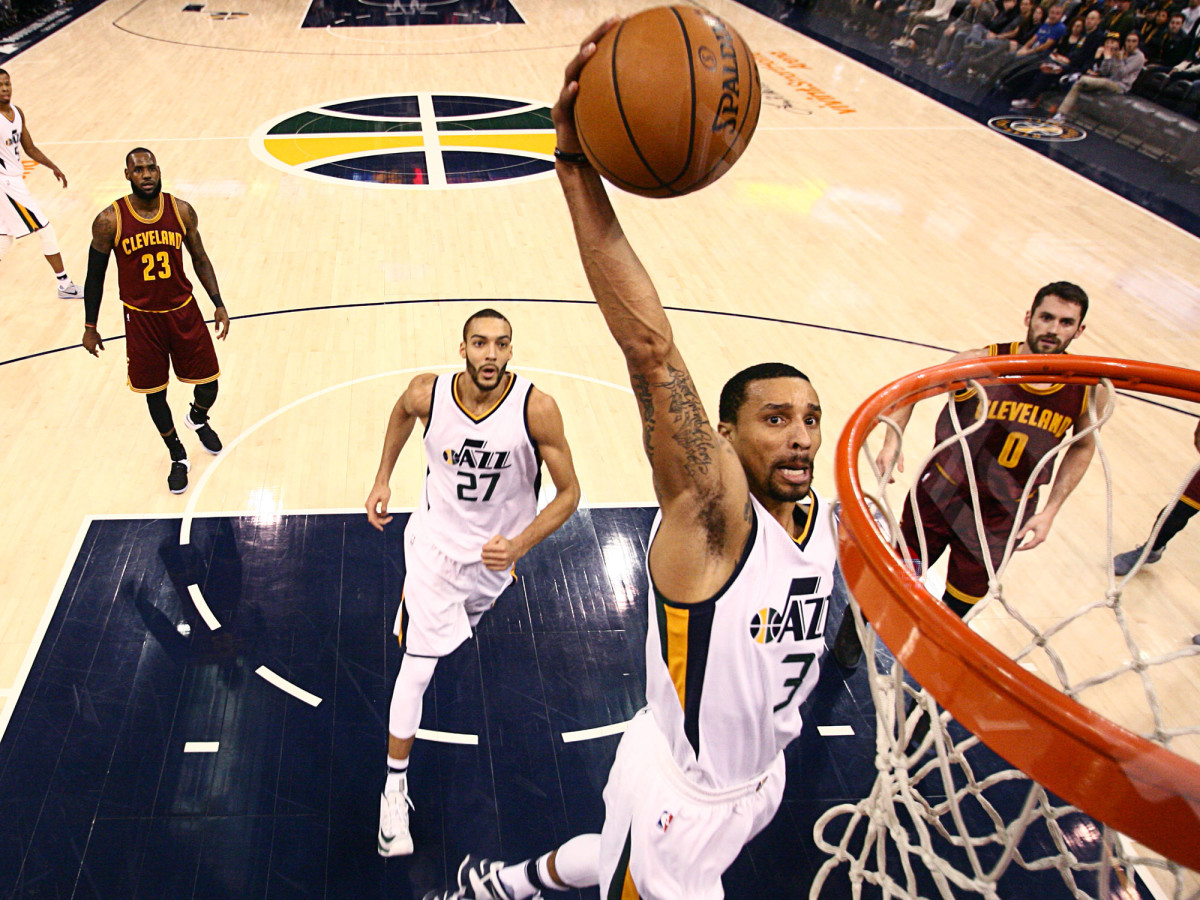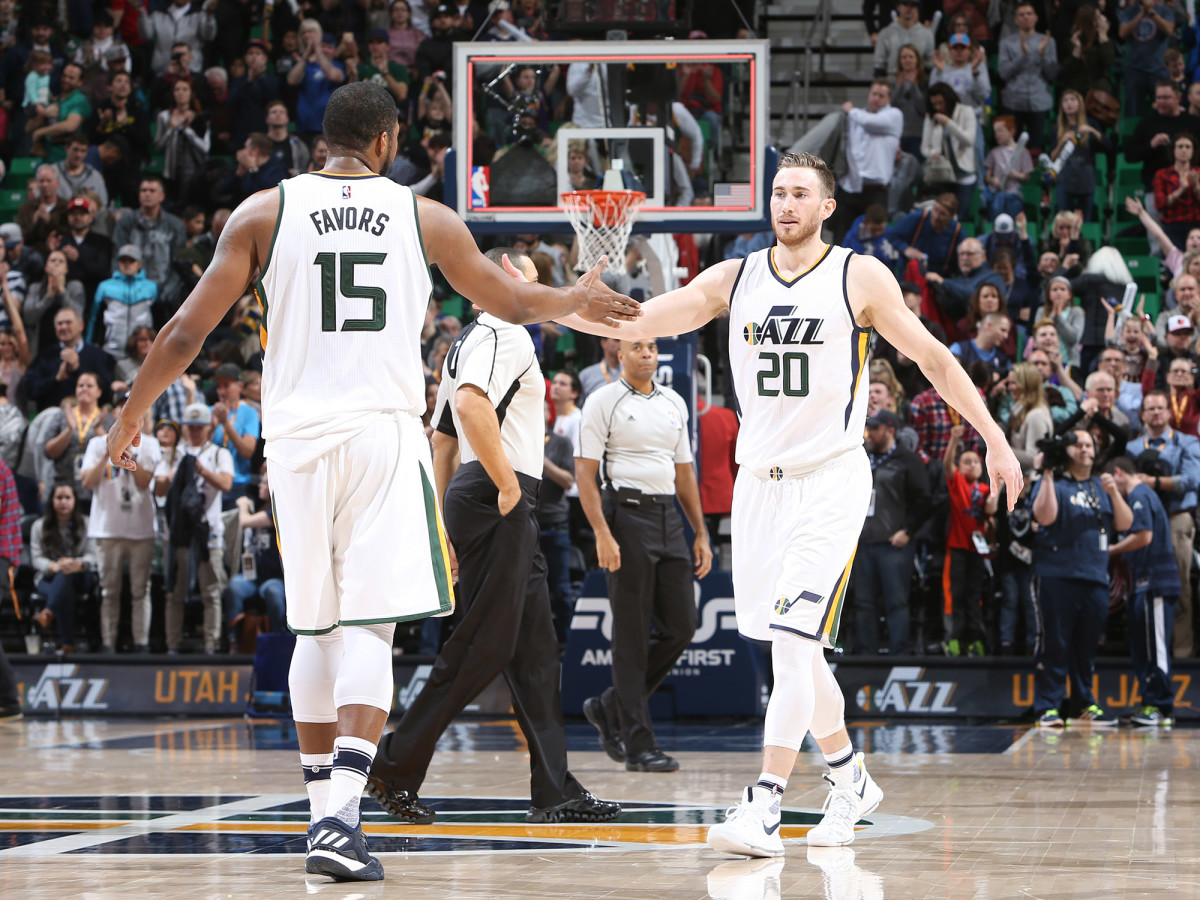Why You Should Watch The Utah Jazz

New York has its dysfunction, the Bay Area its splendor, and Boston its percolating rumor mill. Utah, at long last, has a compelling basketball team—not only in concept, but in action. The idea of the Jazz has piqued the interest of the League Pass cognoscenti for years. Discerning viewers saw players of interest coming into their own. Eager prognosticators preached of Utah’s coming arrival.
There were injuries, there were doubts, and there were crippling struggles in crunch time. Now there is only a playoff-bound roster making good on that promise, some five years removed from its last playoff appearance and longer still from its last gasp of relevance. The Jazz are for real. To the skeptical and the unconvinced, the negligent and the oblivious, allow me to make the case why any basketball fan should really be watching:
The Crossover's 2017 NBA All-Star Reserves
The Jazz are really damn good
Sometimes the best reasons are the simplest. Utah is worthy of your attention because it has demanded it. Rarely have the Jazz had the full, healthy faculties of their roster, and yet to date only five teams—all of them considered title contenders to varying degrees—have won more games. Utah boasts the net rating of a 50–55-win club even without showing fully what it might be capable of. Their performance has made a fascinating statement. Some skepticism is understandable given the Jazz’s recent rise into the league’s upper tiers, but teasing out Utah’s matchups against any of the NBA’s best results in a reasonably winnable proposition. No team lines up well against the Warriors, though the Jazz have both the right kinds of players to give it a go and the stylistic bent to influence how the Warriors play. The Spurs are difficult to manage in entirely different ways, though solid interior defense and length on the perimeter—both Jazz calling cards—could go a long way in blotting out the space and angles San Antonio needs for its offense. Houston was brought to a walk and unsettled in its second meeting with the Jazz this season, and faces its most harsh stylistic friction in a series against Utah.
It’s not outside the realm of possibility that Utah could give some top-notch Western Conference team all that it bargains for in the playoffs, which is reason enough for some regular season investment. This is a formidable team entrenched in the process of becoming. Their share in what is essentially a three-way tie for the best defense in the league makes them an unfavorable draw under any circumstances, particularly given the roundness of their roster. Point guards don’t want to deal with George Hill snaking around screens to stay attached at the hip. Scorers hate to see Rudy Gobert standing between them and the rim. An offense that looks elsewhere for points of weakness will find few, and all the while the Jazz will grind and string out possessions and rack up fouls to apply pressure. The pace Utah employs and the defense it maintains can make any Jazz lead feel double its size. Therein lies the pain in playing them and the theater in watching them. The best version of the Jazz is a vise grip. Or, to put it another way …
The Jazz are a puzzle
If you want to see the best players in the league flustered and the top teams frustrated, tune in for their games against Utah. No opponent is allowed to play their game. Slower, interior-oriented teams are smothered by Gobert and Derrick Favors. Faster teams are brought to a halt and made to execute without a numbers advantage or the simple freedoms of the fast break. Golden State, which averages 103.1 possessions per game, was curtailed to 98.9 against the Jazz—a middle-of-the-pack figure. Houston, which ranks fourth in pace at 101.4 possessions per game, stalled out to 93.5 in two games against Utah. Go down the line and you’ll find that virtually every one of the NBA’s fastest-paced teams is slowed by the Jazz, denied seven or eight possessions from their average.
This kind of pacing renders a completely different sort of competitive environment. The way Utah gums up the works of its opponents forces them to get creative. Blunt force can only be so effective when an elite defense is allowed to set. So opposing stars have to find seams they otherwise might not explore, while their teammates fill roles slightly outside their usual purview. Utah won’t stop everyone. But their style of play and stifling defense bring out a different side in the game’s best, reframing even those teams you might know well.

Variety yields unpredictability
The Russell Westbrook-dominated Thunder are imminently watchable, but much in the way that a multi-cam sitcom might be. The rhythms are familiar. That doesn’t preclude them from being well-executed, but part of the appeal lies in knowing largely what you’re getting from the moment you tune in. Welcome to the Russell Westbrook Show.
Utah, by contrast, is an exercise in variety. There are hallmarks of style and performance that guide the Jazz from night to night, but each of their possessions are long, spiraling odysseys. Ball-handlers work from three or four different angles, probing and passing into the next. Patience allows possessions to develop fully, complete with all kinds of twists and turns. Some are born of the fact that Utah might not have an obvious one-on-one advantage at a given juncture. Others are functions of a pass-happy offense that delights in redirection. Utah runs a top 10 offense by churning; though they rank near the bottom of the league in most assist metrics, the Jazz rotate through their creative options and rack up passes in the process. The virtue of balance is a sense of investment among the players involved. For those watching, it has the added benefit of forcing those involved to do more.
Breaking Down The NBA's 30 Best Contracts
Hayward is an out-and-out star
There’s really no argument to the contrary. Hayward scores as much as Giannis Antetokounmpo, posts a higher true shooting percentage than Klay Thompson, assists more than Paul George, rebounds as well as Kawhi Leonard, and gets to the free throw line more often than Kevin Durant. Want a creator who can hit contested shots? Hayward has a knack for drawing contact and hanging in the air to hit all sorts of difficult, leaning jumpers. Need someone to work the pick-and-roll game? Hayward ranks just below Kyrie Irving, Kemba Walker, and DeMar DeRozan in pick-and-roll efficiency, per Synergy Sports (Hill, by the way, ranks second in the league). Looking for the kind of flexibility befitting the modern NBA? Hayward can realistically swing between three positions while holding his own defensively and keeping the offense moving. Don’t let the glut of talent in the West disguise what should be obvious: Hayward is excellent.

The roster is full of two-way players
The best offensive players in Utah’s regular rotation are largely serviceable defenders at minimum, while the best defensive players in the rotation can all contribute to a healthy offense. Youth is the closest the Jazz get to liability; Trey Lyles is feeling his way through NBA defense and Dante Exum hasn’t quite settled to offensive stability. Both are 21 years old. Most every other nightly contributor can hold their own on either end. There is no one to hide. Utah begins every trip down the floor on solid footing without clear mismatches to be exploited. That every possession is earned makes it all the sweeter.
NBA Stock Watch: Sixers Can't Lose, Westbrook Can't Win
Quin Snyder runs an after-timeout clinic
The reality is this: If you want to operate at a plodding pace and survive in the modern NBA, you had best work from a clever, layered playbook. Snyder brings the goods. Utah leverages its balance in misdirection all over the floor, building off consecutive screens in different directions to throw the defense into the blender. Check out this set that freed up Hayward game-tying three on Monday night:
And this beauty to spring Burks free for a potential game-winner in the corner:
Play-drawing accolades are typically reserved for the likes of Gregg Popovich, Rick Carlisle, Steve Kerr, and Brad Stevens. Snyder deserves inclusion in that group. The man knows his way around a clipboard.
Rudy Gobert challenges everything
The principle of verticality lives on through Gobert. Defense might not always make for riveting television, but there’s something undeniably dramatic about two competitors meeting in midair, desperate to outfox one another before their feet return to the ground. Gobert finds his way into those situations more than any other player in the league. No one contests more shots around the basket, and only two other high-volume rim protectors (Joel Embiid and Kristaps Porzingis) allow a lower percentage on those shots. The results can be sensational. Not only does Gobert lead the league in total blocks (while ranking second in block rate)—his bold, adversarial style puts Gobert in the line of fire against some of the most powerful dunkers in the league:
So kind of the rim to make sure Rudy Gobert came out of this alive pic.twitter.com/hcHqMsAd1g
— Michael Lee (@MrMichaelLee) January 24, 2017
One of these block attempts might well take his arm off.
Utah is one of the last bastions of no-PG lineups
It’s one thing to play without a nominal point guard when you have LeBron James on the floor and quite another to do so in any other context. Utah tinkers with the possibility on occasion—largely because it has enough playmaking wings to get by. Hayward can run pick-and-roll comfortably after years spent working into that role. Rodney Hood, when healthy, is a natural creator who can shake defenders off the dribble. Alec Burks is quick as hell and can balance the floor off the ball. Joe Ingles has the guile and passing to initiate in spots, while Joe Johnson slinks into favorable positions and gives Utah an easily identifiable fallback. Swirl any three—or four, depending on the matchup—of those players into a lineup together and the Jazz can tap into something refreshingly unique if not universally effective.
